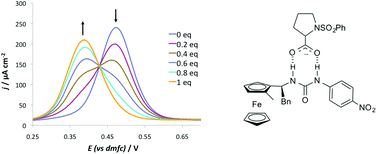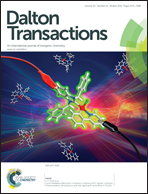The effect of central and planar chirality on the electrochemical and chiral sensing properties of ferrocenyl urea H-bonding receptors†
Abstract
A new series of chiral ureas containing one or two redox-active ferrocene units was synthesised and studied in order to investigate the effect of planar chirality and central chirality on electrochemical chiral sensing. Binding of chiral carboxylate anions in organic solvents through H-bond formation caused a negative shift in the potentials of the ferrocene/ferrocenium (Fc/Fc+) couples of the receptors, demonstrating their use as electrochemical sensors in solution. While the presence of two ferrocene units gave no marked improvement in the chiral sensing capabilities of these systems, the introduction of planar chirality, in addition to central chirality, switched the enantiomeric binding preference of the system and also caused an interesting change in the appearance of some voltammograms, with unusual two-wave behaviour observed upon binding a protected prolinate guest.


 Please wait while we load your content...
Please wait while we load your content...